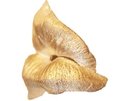SUZANA VAZ, TOKYO, AUGUST 2008.
For a moment, on the whole of the exhibition’s space, disclosed when the curtains descend, one single word: breathe.
The presentation Respira/Breathe has the invisible and preeminent vital force of a deep breath. Rute Rosas realigns her breathing, observes herself, and invites the visitor to do the same, to join up in her pondering.
The video of the opening, showing the record of that minimal event, along with the release of an object, the catalogue, signed and numbered, are the remains of what might have been a conventional exhibition. The latter gathers the essential of Rute Rosas’ work and embodies the present retrospective movement, including also recent works, by the artist, and in co-authorship and collaboration, mostly with young artists.
The iconographical cancellation of Respira/Breathe may be grasped in the continuity of the installation Não Há Príncipe Azul no Elefante Cor-de-Rosa/There is no Blue Prince on the Pink Elephant (April 2008, Espaço Ilimitado, Oporto), from which the artist has excluded some of the distinctive elements of her artistic discourse: representations of her own body, the proposition of direct sensory experiences or of a convivial predisposition (expressed, for example, on the offer of edible items). These elements facilitate the concrete living experience, the emergence of an embodied unconscious and of the creative volition, thus reducing the importance of reading the meaning; besides, they manifest the ego impulse in a physical essentiality, prefigured on the objectivity of the behaviour by the protocol for fruition.
In Não Há Príncipe Azul…,/There is no Blue Prince..., the space of the house – replete with quotidian articles, evocative of memories of life, and exhibited almost museographically – does not contain any device that might lead to a behaviour of access into the body’s materiality, nor any representation of the pure experiential vitality of the body. Life and experience are schematized within the delimited area of the codified discourse, they appear mediated by language, by their inherent meaning, either through the verbal content of the embroidered messages, or through the poetic content of the framed articles and objects in display, simbolically overcharged.
Although immerse on a prepared environment, the visitor nevertheless aprehends the sense of the work through the making of meaning, mainly by a conceptual, discursive or even literary approach.
Within this progression, in which the assertion of the ego shifts from the dynamism of the unconscious to the deliberation of the conscious, Respira/Breathe may be viewed as an unreserved compliance with the exercise of consciousness, that resets the ego’s role as negotiating centre of the conscious process, as agent of mediation between the personal unconscious, reality, and the persona. The persona that emerges from the presentation Respira/Breathe is introspective and discrete. It is envelopped by the verbal code, sheltered by the linguistic consciousness. It is mediate, inclined to the examination of the impulses. It poises itself on the reflective silence of reading, where all that remains is the murmur of breathing, a residual trace of physiology.
Simultaneously with Respira/Breathe, Rute Rosas revisits, in Cerveira, the residency Faço de conta que és tu/Make believe (Berlin, 2004, Galerie 35), maintaining its central icon, a wooden object that stylizes, in natural size, the figure of a body with bent legs, to be laid down on its chairlike position. The comparative reading of the two projects, within the idea of symbolical transmutation that is the core of the individuation process, supports the interpretation of a persona that chooses to observe instead of acting, dissociated of the reverie that the icon formerly arose.
On the project of the original residency, the artist slept with the wooden figure on the same bed where it layed, using it almost as an object of substitution. The pretence of interaction stressed an unrequited expectation, a longing, the dramatically overcharged atmosphere of attachment.
In Cerveira, the wooden figure rested two nights on the back of a van, inside a black bag, from which it was taken out to be laid on a bunk bed of an inn, on the room beneath the one where the artist slept in. To the sparing of gestures that results from the absence of interaction initiatives corresponds a reduction on the energy of the psyche in its denser plans, the physical and the emotional, and these factors confirm the erasure of the symbol, that has expired as a dynamic structure of the individuation process.
Meanwhile, a few final procedures compose a new image: the wooden figure will be laid on one of the sides of a bed split in two – literally, revealing all the layers of fibre, from the matress to the cover – a sculpture object that carries, also in directly aprehensible meanings, what is left of the biographical cycle. This piece will be part of the collection of the Museu da Bienal de Cerveira, in which the artist is already represented with her installation work Da Terra ao Céu/From Earth to Heaven, that was awarded the Prémio Bienal de Cerveira/Prize Bienal de Cerveira in 2005.














